A Japanese garden may seem bare and minimalist, but designing a true Japanese garden is not a simple task. Every element of its design is carefully chosen and placed to create a look of seamless beauty that reflects the natural world outside the garden walls. It takes time and effort, and a true Japanese garden is never really finished, just as nature is always changing.
Just a quick look at the design principles may overwhelm you. There are numerous styles, an even larger number of rules and meanings for each element, and occasionally conflicting advice. On the plus side there are groups, classes, books and websites that are devoted to the intricacies of creating these spaces.
If you love the style but aren't quite ready for a full commitment, you can still incorporate many of the design principles in your own landscape. Read on to see how
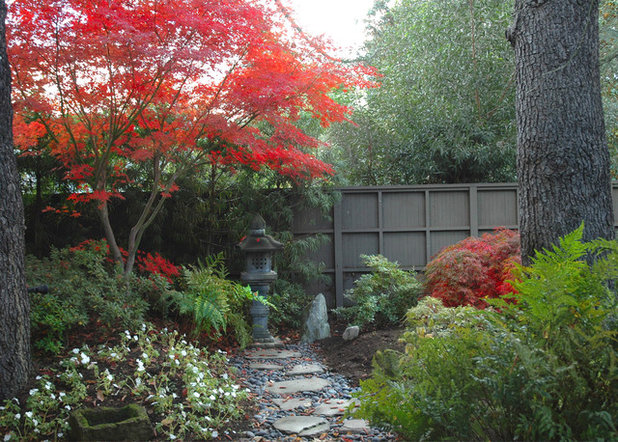
Richard Kramer
Temper balance and symmetry with imperfection. The Japanese maples on either side of the path, in addition to providing a bright spot of color in an otherwise green landscape, are almost matching in color and placement but contrast completely in size. The lantern and upright boulder match in size and color but differ in form, from the obviously man-made to the obviously natural. Even the color of the Asian-inspired gridded fence matches that of the bark of the tree, and both blend with the soft colors of the plantings.
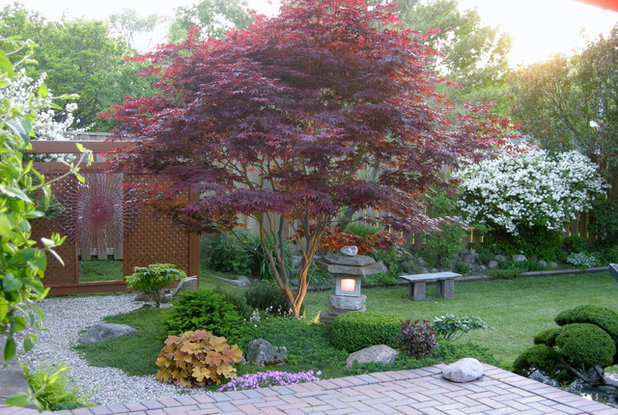 Work with what you have.
Work with what you have. A Japanese garden is intended to replicate the natural world that surrounds it in a smaller space. If your space is flat, as here, create a small mound or two to add interest, but don’t try to turn is into a hillside garden. If, instead, your land is naturally sloped, use that to your advantage and add a waterfall or stream that follows the lay of the land.
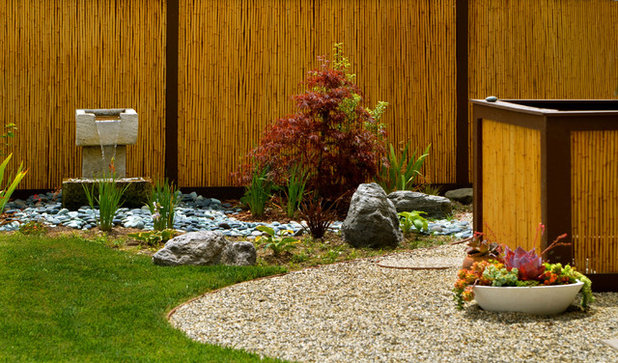
Jesse Im/bugonmyleaf
Enclose the space. Because these gardens are a microcosm of the world outside, fences and gates play an important role. Fences create boundaries that set the garden apart. The trick is to keep these barriers from feeling harsh or forbidding. Fences are simple in design and designed to blend with or set off the landscape they enclose. Plantings may conceal part of the fence to both soften it and hint at a world beyond, or the fence itself may be painted to blend into the rest of the yard rather than stand out sharply. The opposite approach is the fence that is opened up in one spot to capture a view beyond the garden itself, maybe a mountain vista or even a tree in bloom in a neighbor’s yard. Bamboo is an obvious choice as a fencing material, but wooden fences, especially those with a grid pattern, will also work.
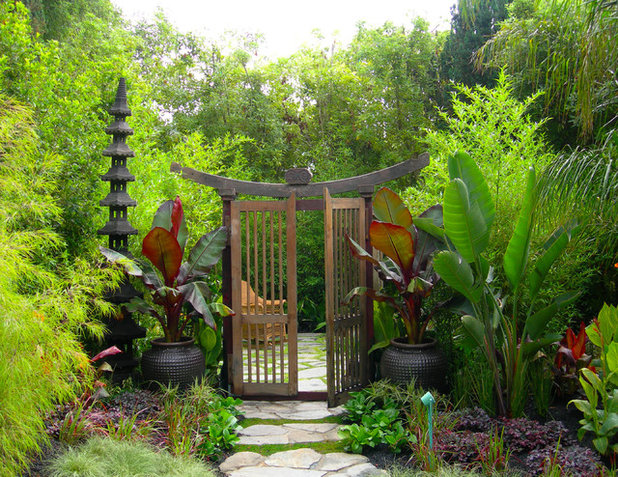
Zeterre Landscape Architecture
Rather than shutting the world out, gates often are created with open gridwork or a lath design that allows glimpses both into and out of the garden.
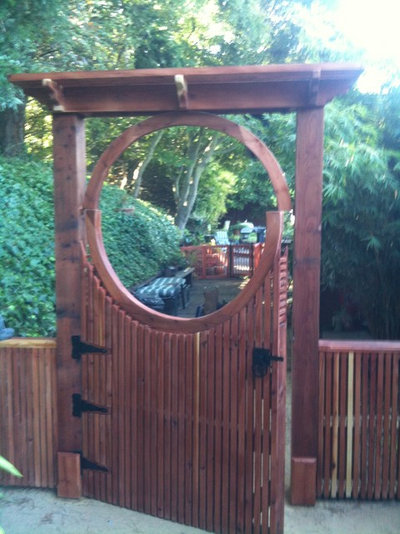
360 Yardware
A moon gate is a simple way to add an Asian feel to a space as well. Though traditionally the round opening would extend from the overhead to the ground, this version is a good, and easily secured, alternative that allows an intriguing view to the space beyond.
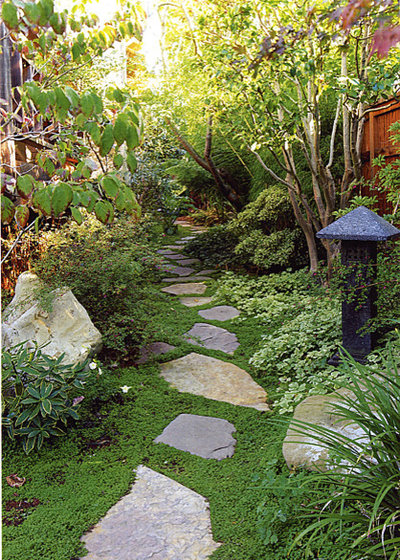
Goodman Landscape Design
Decide on the type of garden you want. Some Japanese gardens are designed as strolling gardens. The stone pathway twists a bit as it follows the fence line. Surrounded by a low ground cover that resembles moss, an often-used ground cover itself, the path disappears at the end of the yard. You may know, intellectually, that it just goes to the fence, but it appears to continue to a distant destination.
Boulders and mixed plantings line the path in a causal and irregular mix that creates a sense of balance while still providing movement through the space. Though most of the elements are taken straight out of nature, the dark stone lantern hints at a human presence.
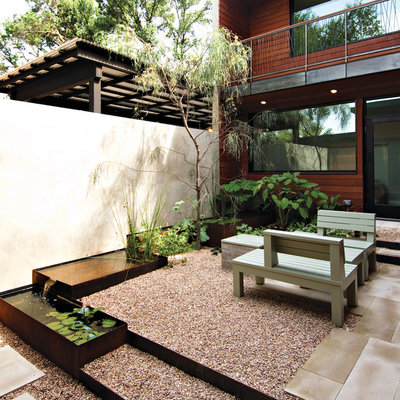
Jobe Corral Architects
A courtyard garden is another classic Japanese garden. This one has the standard design elements — gravel, water, accent tree — but with a contemporary twist. Rather than a natural-looking pond and a soft-edge gravel patio, usually the hallmarks of a Japanese garden, straight edges border the tiered water feature and patio.The accent tree is thin but tall, rather than kept low. Even the furniture has a modern look, with the extended benches and not-quite-nature-inspired green. But the end result is just as peaceful as a traditional Japanese garden.
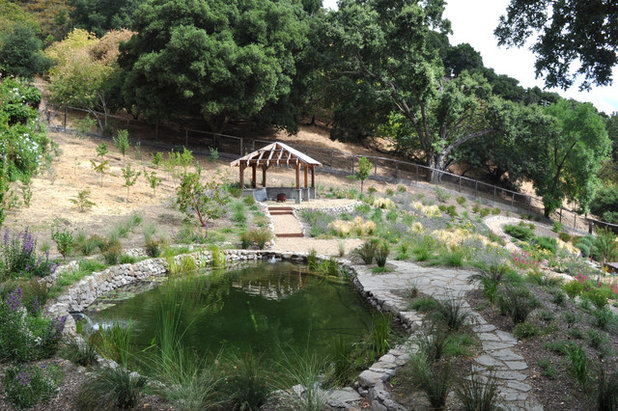
Huettl Landscape Architecture
This is a garden designed to be viewed as well as to take in the borrowed view. The vista from the house is striking, but you'll get equally stunning views from the pagoda or the chairs.
The open boundaries make this more of a modern nod to traditional design, but the principles still apply.
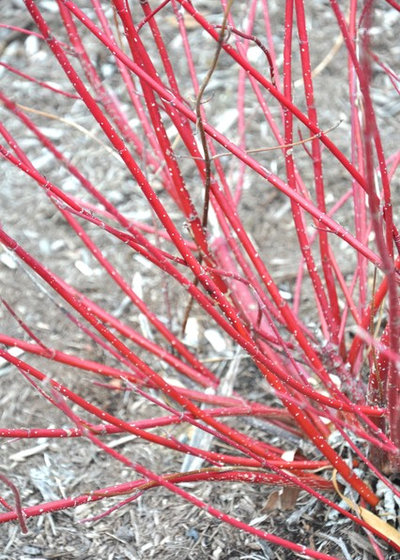
U. of Maryland Arboretum & Botanical Garden
Plan for four seasons. Japanese gardens are designed to be enjoyed year-round. For that reason, the basic structure of the garden is important. It must look equally beautiful when stripped of leaves or when covered in snow as it does in the height of spring and summer. And sometimes the beauty of a plant in winter, such as this redtwig dogwood, may even outshine its summer glory.
Next: Elements of Japanese Garden Design





